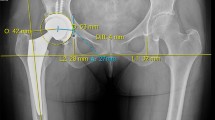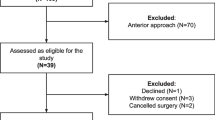Abstract
Background
Restoration of biomechanics is a major goal in THA. Imageless navigation enables intraoperative control of leg length equalization and offset reconstruction. However, the effect of navigation compared with intraoperative fluoroscopy is unclear.
Questions/purposes
We asked whether intraoperative use of imageless navigation (1) improves the relative accuracy of leg length and global and femoral offset restoration; (2) increases the absolute precision of leg length and global and femoral offset equalization; and (3) reduces outliers in a reconstruction zone of ± 5 mm for leg length and global and femoral offset restoration compared with intraoperative fluoroscopy during minimally invasive (MIS) THA with the patient in a lateral decubitus position.
Methods
In this prospective study a consecutive series of 125 patients were randomized to either navigation-guided or fluoroscopy-controlled THA using sealed, opaque envelopes. All patients received the same cementless prosthetic components through an anterolateral MIS approach while they were in a lateral decubitus position. Leg length, global or total offset (representing the combination of femoral and acetabular offset), and femoral offset differences were restored using either navigation or fluoroscopy. Postoperatively, residual leg length and global and femoral offset discrepancies were analyzed on magnification-corrected radiographs of the pelvis by an independent and blinded examiner using digital planning software. Accuracy was defined as the relative postoperative difference between the surgically treated and the unaffected contralateral side for leg length and offset, respectively; precision was defined as the absolute postoperative deviation of leg length and global and femoral offset regardless of lengthening or shortening of leg length and offset throughout the THA. All analyses were performed per intention-to-treat.
Results
Analyzing the relative accuracy of leg length restoration we found a mean difference of 0.2 mm (95% CI, −1.0 to +1.4 mm; p = 0.729) between fluoroscopy and navigation, 0.2 mm (95 % CI, −0.9 to +1.3 mm; p = 0.740) for global offset and 1.7 mm (95 % CI, +0.4 to +2.9 mm; p = 0.008) for femoral offset. For the absolute precision of leg length and global and femoral offset equalization, there was a mean difference of 1.7 ± 0.3 mm (p < 0.001) between fluoroscopy and navigation. The biomechanical reconstruction with a residual leg length and global and femoral offset discrepancy less than 5 mm and less than 8 mm, respectively, succeeded in 93% and 98%, respectively, in the navigation group and in 54% and 95%, respectively, in the fluoroscopy group.
Conclusions
Intraoperative fluoroscopy and imageless navigation seem equivalent in accuracy and precision to reconstruct leg length and global and femoral offset during MIS THA with the patient in the lateral decubitus position.
Level of Evidence
Level I, therapeutic study. See the Instructions for Authors for a complete description of levels of evidence.






Similar content being viewed by others
References
Bourne RB, Rorabeck CH. Soft tissue balancing: the hip. J Arthroplasty. 2002;17:17–22.
Cheng T, Feng JG, Liu T, Zhang XL. Minimally invasive total hip arthroplasty: a systematic review. Int Orthop. 2009;33:1473–1481.
Committee for Proprietary Medicinal Products (CPMP). Committee for Proprietary Medicinal Products (CPMP): points to consider on adjustment for baseline covariates. Stat Med. 2004;23:701–709.
Dastane M, Dorr LD, Tarwala R, Wan Z. Hip offset in total hip arthroplasty: quantitative measurement with navigation. Clin Orthop Relat Res. 2011;469:429–436.
Duwelius PJ, Dorr LD. Minimally invasive total hip arthroplasty: an overview of the results. Instr Course Lect. 2008;57:215–222.
Ezzet KA, McCauley JC. Use of intraoperative x-rays to optimize component position and leg length during total hip arthroplasty. J Arthroplasty. 2014;29:580–585.
Friberg O. Clinical symptoms and biomechanics of lumbar spine and hip joint in leg length inequality. Spine (Phila Pa 1976). 1983;8:643–651.
Gurney B, Mermier C, Robergs R, Gibson A, Rivero D. Effects of limb-length discrepancy on gait economy and lower-extremity muscle activity in older adults. J Bone Joint Surg Am. 2001;83:907–915.
Hayakawa K, Minoda Y, Aihara M, Sakawa A, Ohzono K, Tada K. Acetabular component orientation in intra- and postoperative positions in total hip arthroplasty. Arch Orthop Trauma Surg. 2009;129:1151–1156.
Hofmann AA, Bolognesi M, Lahav A, Kurtin S. Minimizing leg-length inequality in total hip arthroplasty: use of preoperative templating and an intraoperative x-ray. Am J Orthop (Belle Mead NJ). 2008;37:18–23.
Hofmann AA, Skrzynski MC. Leg-length inequality and nerve palsy in total hip arthroplasty: a lawyer awaits! Orthopedics. 2000;23:943–944.
Jung HJ, Jung YB, Song KS, Park SJ, Lee JS. Fractures associated with computer-navigated total knee arthroplasty: a report of two cases. J Bone Joint Surg Am. 2007;89:2280–2284.
Konyves A, Bannister GC. The importance of leg length discrepancy after total hip arthroplasty. J Bone Joint Surg Br. 2005;87:155–157.
Lecerf G, Fessy MH, Philippot R, Massin P, Giraud F, Flecher X, Girard J, Mertl P, Marchetti E, Stindel E. Femoral offset: anatomical concept, definition, assessment, implications for preoperative templating and hip arthroplasty. Orthop Traumatol Surg Res. 2009;95:210–219.
Li CH, Chen TH, Su YP, Shao PC, Lee KS, Chen WM. Periprosthetic femoral supracondylar fracture after total knee arthroplasty with navigation system. J Arthroplasty. 2008;23:304–307.
Little NJ, Busch CA, Gallagher JA, Rorabeck CH, Bourne RB. Acetabular polyethylene wear and acetabular inclination and femoral offset. Clin Orthop Relat Res. 2009;467:2895–2900.
Malik A, Maheshwari A, Dorr LD. Impingement with total hip replacement. J Bone Joint Surg Am. 2007;89:1832–1842.
Maloney WJ, Keeney JA. Leg length discrepancy after total hip arthroplasty. J Arthroplasty. 2004;19:108–110.
Manzotti A, Cerveri P, De Momi E, Pullen C, Confalonieri N. Does computer-assisted surgery benefit leg length restoration in total hip replacement? Navigation versus conventional freehand. Int Orthop. 2011;35:19–24.
Meermans G, Malik A, Witt J, Haddad F. Preoperative radiographic assessment of limb-length discrepancy in total hip arthroplasty. Clin Orthop Relat Res. 2011;469:1677–1682.
Michel MC, Witschger P. MicroHip: a minimally invasive procedure for total hip replacement surgery using a modified Smith-Peterson approach. Ortop Traumatol Rehabil. 2007;9:46–51.
Nishio S, Fukunishi S, Fukui T, Fujihara Y, Yoshiya S. Adjustment of leg length using imageless navigation THA software without a femoral tracker. J Orthop Sci. 2011;16:171–176.
Patel S, Thakrar RR, Bhamra J, Hossain F, Tengrootenhuysen M, Haddad FS. Are leg length and hip offset comparable after hip resurfacing and cementless total hip arthroplasty? Ann R Coll Surg Engl. 2011;93:465–469.
Ranawat CS, Rao RR, Rodriguez JA, Bhende HS. Correction of limb-length inequality during total hip arthroplasty. J Arthroplasty. 2001;16:715–720.
Reininga IH, Zijlstra W, Wagenmakers R, Boerboom AL, Huijbers BP, Groothoff JW, Bulstra SK, Stevens M. Minimally invasive and computer-navigated total hip arthroplasty: a qualitative and systematic review of the literature. BMC Musculoskelet Disord. 2010;11:92.
Renkawitz T, Haimerl M, Dohmen L, Gneiting S, Wegner M, Ehret N, Buchele C, Schubert M, Lechler P, Woerner M, Sendtner E, Schuster T, Ulm K, Springorum R, Grifka J. Minimally invasive computer-navigated total hip arthroplasty, following the concept of femur first and combined anteversion: design of a blinded randomized controlled trial. BMC Musculoskelet Disord. 2011;12:192.
Renkawitz T, Schuster T, Grifka J, Kalteis T, Sendtner E. Leg length and offset measures with a pinless femoral reference array during THA. Clin Orthop Relat Res. 2010;468:1862–1868.
Renkawitz T, Tingart M, Grifka J, Sendtner E, Kalteis T. Computer-assisted total hip arthroplasty: coding the next generation of navigation systems for orthopedic surgery. Expert Rev Med Devices. 2009;6:507–514.
Renkawitz T, Worner M, Sendtner E, Weber M, Lechler P, Grifka J. [Principles and new concepts in computer-navigated total hip arthroplasty][in German]. Orthopade. 2011;40:1095–1102.
Sakalkale DP, Sharkey PF, Eng K, Hozack WJ, Rothman RH. Effect of femoral component offset on polyethylene wear in total hip arthroplasty. Clin Orthop Relat Res. 2001;388:125–134.
Singer G. Occupational radiation exposure to the surgeon. J Am Acad Orthop Surg. 2005;13:69–76.
Spalding TJ. Effect of femoral offset on motion and abductor muscle strength after total hip arthroplasty. J Bone Joint Surg Br. 1996;78:997–998.
Varghese B, Muthukumar N, Balasubramaniam M, Scally A. Reliability of measurements with digital radiographs: a myth. Acta Orthop Belg. 2011;77:622–625.
Woolson ST, Hartford JM, Sawyer A. Results of a method of leg-length equalization for patients undergoing primary total hip replacement. J Arthroplasty. 1999;14:159–164.
Worner M, Weber M, Lechler P, Sendtner E, Grifka J, Renkawitz T. [Minimally invasive surgery in total hip arthroplasty: surgical technique of the future?][in German]. Orthopade. 2011;40:1068–1074.
Author information
Authors and Affiliations
Corresponding author
Additional information
The institution of one or more of the authors (MW, MW, RS, ES, JG, TR) has received funding from the German Federal Ministry of Education and Research, project number 01EZ091.
All ICMJE Conflict of Interest Forms for authors and Clinical Orthopaedics and Related Research editors and board members are on file with the publication and can be viewed on request.
Each author certifies that his or her institution approved the human protocol for this investigation, that all investigations were conducted in conformity with ethical principles of research, and that informed consent for participation in the study was obtained.
This work was performed at Regensburg University Medical Center, Department of Orthopedic Surgery, Bad Abbach, Germany.
About this article
Cite this article
Weber, M., Woerner, M., Springorum, R. et al. Fluoroscopy and Imageless Navigation Enable an Equivalent Reconstruction of Leg Length and Global and Femoral Offset in THA. Clin Orthop Relat Res 472, 3150–3158 (2014). https://doi.org/10.1007/s11999-014-3740-5
Received:
Accepted:
Published:
Issue Date:
DOI: https://doi.org/10.1007/s11999-014-3740-5




